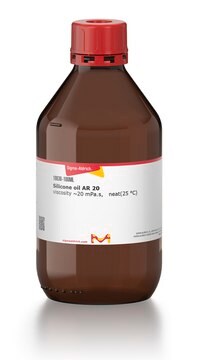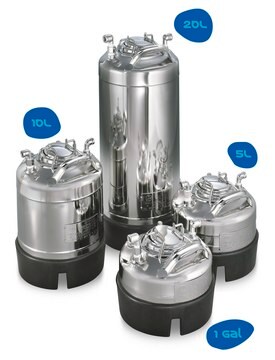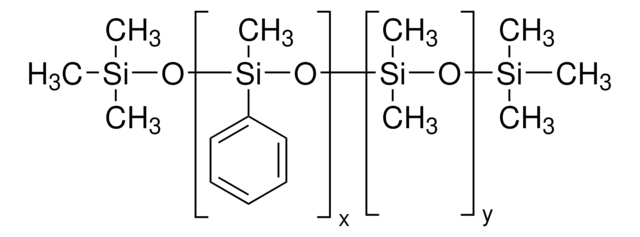146153
Siliconöl
for melting point and boiling point apparatuses
Anmeldenzur Ansicht organisationsspezifischer und vertraglich vereinbarter Preise
Alle Fotos(1)
About This Item
Lineare Formel:
[-Si(CH3)2O-]n
CAS-Nummer:
MDL-Nummer:
UNSPSC-Code:
41100000
NACRES:
NB.77
Empfohlene Produkte
Dampfdichte
>1 (vs air)
Dampfdruck
<5 mmHg ( 25 °C)
5 mmHg ( 20 °C)
Typ
for melting point and boiling point apparatuses
Parameter
−40-350 °F temp. range (−40-175 °C)
Brechungsindex
n20/D 1.403 (lit.)
Viskosität
45.0-55.0(25 °C)
bp
>140 °C/0.002 mmHg (lit.)
Dichte
0.963 g/mL at 25 °C
Suchen Sie nach ähnlichen Produkten? Aufrufen Leitfaden zum Produktvergleich
Anwendung
Silicone oil has been used:
- for melting-point and boiling-point apparatus
- in membrane contactors to impregnate fibers
- on rheometer samples (chicken skin and bovine gelatin) to prevent evaporation during heating using temperature sweeps and frequency sweeps
Biochem./physiol. Wirkung
Silicone oil is suitable for use in under-oil screenings of proteins.
Leistungsmerkmale und Vorteile
- High viscosity
- Low water solubility
- Low vapor pressure
Lagerklassenschlüssel
10 - Combustible liquids
WGK
WGK 1
Flammpunkt (°F)
214.0 °F - closed cup
Flammpunkt (°C)
101.1 °C - closed cup
Persönliche Schutzausrüstung
Eyeshields, Gloves
Hier finden Sie alle aktuellen Versionen:
Besitzen Sie dieses Produkt bereits?
In der Dokumentenbibliothek finden Sie die Dokumentation zu den Produkten, die Sie kürzlich erworben haben.
Kunden haben sich ebenfalls angesehen
Sara Sanders et al.
PloS one, 13(5), e0197638-e0197638 (2018-05-18)
The in vivo microenvironment of bacterial pathogens is often characterized by nutrient limitation. Consequently, conventional rich in vitro culture conditions used widely to evaluate antibacterial agents are often poorly predictive of in vivo activity, especially for agents targeting metabolic pathways.
Tindaro Ioppolo et al.
Journal of visualized experiments : JoVE, (71)(71), e50199-e50199 (2013-02-15)
Optical modes of dielectric micro-cavities have received significant attention in recent years for their potential in a broad range of applications. The optical modes are frequently referred to as "whispering gallery modes" (WGM) or "morphology dependent resonances" (MDR) and exhibit
Benjamin R Schudel et al.
Lab on a chip, 13(5), 811-817 (2013-01-31)
RNA interference (RNAi) is a powerful tool for functional genomics with the capacity to comprehensively analyze host-pathogen interactions. High-throughput RNAi screening is used to systematically perturb cellular pathways and discover therapeutic targets, but the method can be tedious and requires
Ryan G Porter et al.
Otology & neurotology : official publication of the American Otological Society, American Neurotology Society [and] European Academy of Otology and Neurotology, 34(2), 304-310 (2013-02-28)
To describe a successful paradigm for the treatment of large acoustic neuromas (vestibular schwannomas). Retrospective case review. Tertiary referral center. The charts of 2,875 acoustic neuroma patients at Michigan Ear Institute were reviewed to identify 153 patients who underwent surgical
Zhentian Shi et al.
Journal of the Air & Waste Management Association (1995), 63(1), 80-86 (2013-03-02)
The use of surfactants during soil washing process can create massive foam, which has a negative impact on the effective use of equipment. A series of tests was conducted to evaluate the defoaming performance of three defoamers and to investigate
Unser Team von Wissenschaftlern verfügt über Erfahrung in allen Forschungsbereichen einschließlich Life Science, Materialwissenschaften, chemischer Synthese, Chromatographie, Analytik und vielen mehr..
Setzen Sie sich mit dem technischen Dienst in Verbindung.






